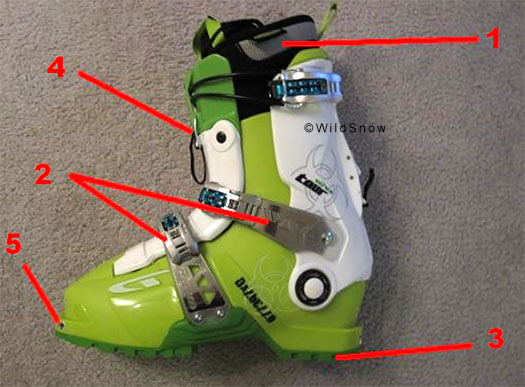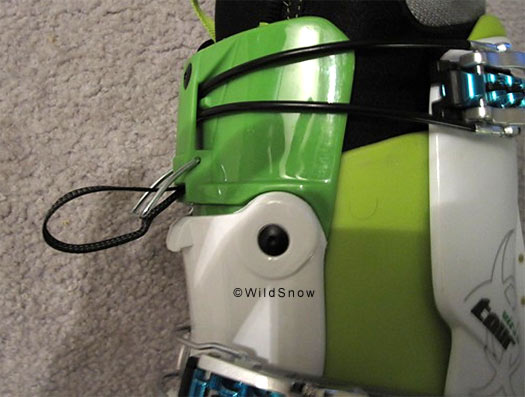Whenever I head into the backcountry I know that I’m compromising some of my ski performance for the freedom of uphill travel. Obviously some hard charging performance, traded for the beauty, adventure, and untouched nature of the backcountry is a good deal; otherwise we all might be in the resort pounding iced over moguls. But.
There has always been a lot of talk about that “holy grail” of touring boots. Something that can walk and boot pack with minimal resistance and maximum cuff movement but ski like a high end alpine boot, all while not tipping the scale in an unfavorable direction. This past year Dalbello along with Glen Plake proudly announced that they had the answer. The new Dalbello Virus boot line would be based on previous iterations of Dalbello boots and what many of us call the old-school ‘flexon’ style tongue design. WildSnow got a copy of the Virus a while ago, and we’ve been passing them around for some real world testing. Time for some review action.

Dalbello Virus backcountry skiing boots. Interesting style and features.
Boy, Glen Plake or Dalbello has an interesting sense of style. I’ll leave it at that…but, the boots do seem to be well constructed. A couple of the big details I noticed right away:
1) Intuition thermo moldable liner (with laces).
2) Metal banding flush mounted to the boot allowing buckles to be out of harms way, easily removed with hex wrench.
3) Vibram sole.
4) Unique tongue latch that allows more cuff movement, rearward.
5) And of course ‘tech’ fittings.
After figuring out how all the doohickeys (the buckles are a bit unusual but they function fine), latches, and what-not worked on these boots I was off for a tour. Virus has a somewhat unique feature on the boot’s tongue, allowing additional rearward movement of the top of the tongue. With the boot in walk mode and the top of the cuff “disengaged” the boots rearward travel was impressive. Long strides on flat or low angle terrain were fluid and had little resistance. However, once the terrain got steeper the boot started to perform in similar fashion or worse than other tongue boots I have used. Due to the relatively high, stiff nature of the tongue there was almost constant shin pressure on steeper skin tracks. Even with all the buckles undone I could feel the tongue of the boot.
What we don’t understand is why, if Dalbello went to the effort of making the Virus tongue flex so nicely to the rear in touring mode, could they not have provided more forward flex as well? In terms of rear flex, perhaps Plake needed a boot for those long flat approaches to some of the Sierra East Side giants? But, once he’s climbing the steeps of those peaks, he must notice the lack of forward movement in his boot.
Lack of forward touring flex is not the end of the world (and can be tuned out somewhat by buckle tightenes slection. But get up on your heel lifters while using the Virus, and you’ll notice the fronts of your shins. Thus, if Virus had forward cuff movement rivaling their rearward travel, this boot could really be a stand out. As the Virus performs now, it is shorter tours, slackcountry, and bootpacking that seem to be what its designers had in mind.

Unique tongue latch allowing for additional rear-ward cuff movement.
After about 3000 vert of up I decided it was about time to turn these puppies loose and see if they really lived up to their reputation. The first thing I noticed after wrenching the Virus’s buckles down tight what that this boot feels eerily similar to an alpine boot. Laterally they are very responsive, noticeably more so than other AT boots I have skied. This beefy lateral response is indeed confidence inspiring — enough so to make up for some of my complaints on the uphill. The forward flex is adequate but not overwhelmingly stiff. I think that due to the high tongue the Virus skied a bit stiffer than they really are.
In alpine mode overall, the most notable feeling in these boots was what for me is an overly upright stance. I was a bit thrown off by this at first but they seemed to ski ok anyway (boot fitting tweaks could probably adjust the stance to suit most skiers). On hard pack the boot’s progressive flex made up for the upright stance and I was able to pressure the tips of my ski as I would normally.
Though perhaps over-hyped last winter, Virus is an interesting boot that could be very nice for skiers who like the “Flexon” type of construction and flex, yet want a boot that will go backcountry with adequate uphill comfort. I think this boot is great for what it was designed for, confidence inspiring, and skis very close to a full-on alpine boot. However, if you’re skiing lap after lap, touring up steep skin tracks this boot is probably going to be a bit cumbersome.
Our Virus test boots with Intuition liner weigh 1862 grams per boot, sole length 317 mm, size 10. This is indeed very light for a fully functional and stiff backcountry boot, but not revolutionary. The Virus “lite” model (Pebax plastic) is significantly lighter. It’s said that you can order stiffer tongues for the Virus through a dealer. Changing to different tongues is a time honored way of stiffening or softening ski touring boots (Scarpa has done a good job of accommodating this by providing super stiff tongues), so we’re glad to hear Dalbello is on the case.
Bottom line: If you’re skiing slackcountry or going on shorter tours and want one of the most alpine-esqe touring boots out there this is probably a good bet.
Biases
1) Although the design, development, and history of the ‘Flexon’ style of ski boots is an interesting and well thought out concept, I’m still skeptical. While it does a great job of reducing boot distortion (what it was designed for) I feel like it lacks in mimicking basic human foot and ankle ergonomics.
2) I come from a ski racing background. Skiing fast, downhill performance oriented, plug boots…you get the picture.
3) I like my boots to tour well on the uphill. I’m well aware that they won’t be as stiff, precise or confidence inspiring as my plug boots but then again I’m not racing so I can handle that. (I normally ski on Garmont Radiums…for comparison sake).
(Guest blogger Tyler Christoff, 26 years old, grew up ski racing. He raced at Syracuse University, making Nationals multiple years. Three years ago he moved to Aspen to pursue a different sort of skiing. Tyler has rapidly grown into a strong mountaineer, and has the perfect form that most skiers only dream of. Tyler is a member of the soon-to-happen WildSnow Denali ski expedition.)
Tyler Christoff grew up ski racing. He raced at Syracuse University, making Nationals multiple years. A few years ago he moved to Aspen to pursue a different sort of skiing. Tyler has rapidly grown into a strong mountaineer, and has the perfect form that most skiers only dream of. He is one of our favorite ski testers since he hits backcountry skiing regularly.
